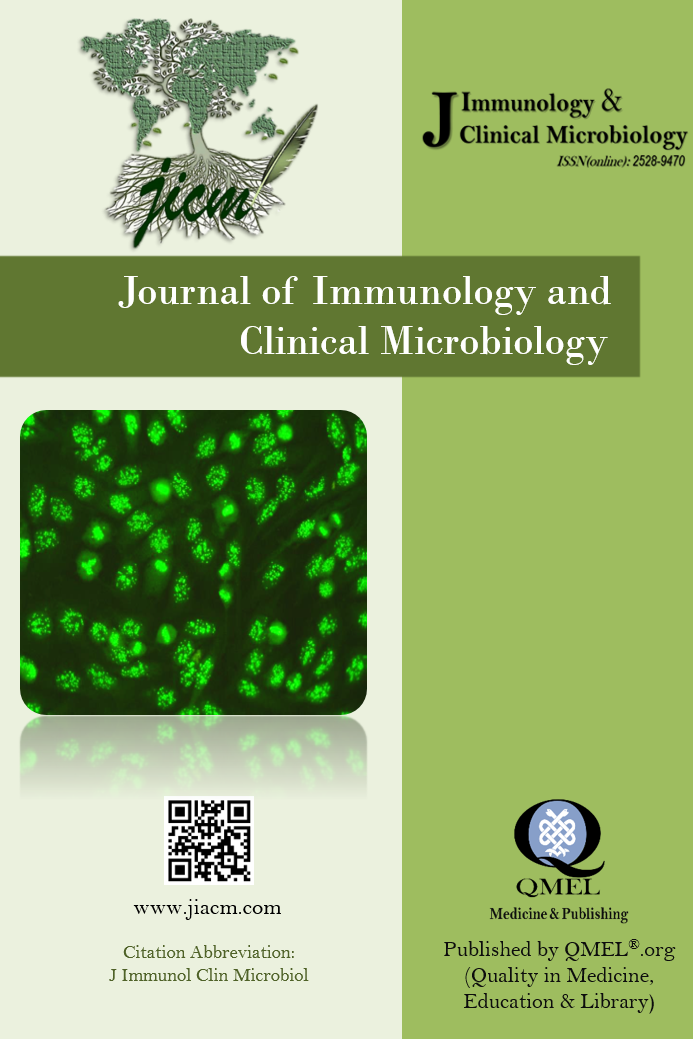ÇOCUKLUK YAŞ GRUBUNDA NADİR GÖRÜNEN BİR OLGU SUNUMU: RADIUS'TA SALMONELLA OSTEOMYELİTİ
Giriş: Salmonella osteomiyeliti, orak hücreli anemi veya talasemi gibi hemoglobinopatilere eşlik eden nadir bir durumdur. Literatürde predispozan faktörlerin olmadığı çocuklarda çok az vaka bildirilmiştir. Burada, bilinen herhangi bir predispozan durum olmaksızın immünokompetan 6 yaşındaki bir çocuğun yarıçapında gelişen bir Salmonella osteomiyeliti olgusunu sunuyoruz.
Olgu sunumu: Altı yaşında hasta, düşme sonrası 20 gündür devam eden sol ön kolda ağrı ve 39,5 derece Celcius ateşi yakınmalarıyla çocuk acil servisine başvurdu. Radyografilerde Radius boyunca litik lezyonlar tespit edildi ve MRG'de Radius’ta infiltratif tipte lezyon izlendi. Osteomiyelit veya malign lezyon şüphesiyle ameliyathanede genel anestezi altında kemik kültürü ve patolojik inceleme için örnekler alındı. Kültürde çok yoğun Salmonella Species üremesi oldu. Pediatrik konsültasyondan sonra hastaya her 8 saatte bir 400 mg vankomisin ve 3 hafta boyunca her 12 saatte bir 1 g seftriakson intravenöz olarak verildi. Hasta 2 hafta boyunca 12 saatte bir 300 mg oral sefuroksim tedavisi ile ayaktan takip edildi. Postoperatif 6. sırada MR ve X-Ray görüntüleme yapıldı. Yarıçapta litik lezyonun önemli ölçüde azaldığı görüldü. Postoperatif 14. ayda MR görüntülemesinde lezyonun kaybolduğu görüldü.
Sonuç: Uzun süreli sinsi semptomları olan hastaların ayırıcı tanısında nadir patojenler düşünülmelidir ve hedefe yönelik antibiyotik tedavisi için uygun kültürlerin alınması gerekmektedir.
Anahtar Kelimeler:
osteomyelit, salmonella, çocuk, radius
A RARE CASE REPORT IN THE CHILDHOOD AGE GROUP: SALMONELLA OSTEOMYELITIS OF THE RADIUS
Introduction: Salmonella osteomyelitis is a rare condition predominantly seen in hemoglobinopathies such as sickle cell anemia or thalassemia. Very few cases have been reported in the literature in children without predisposing factors. Here, we present a case of Salmonella osteomyelitis developing in the radius of an immunocompetent 6-year-old child without any known predisposing conditions.
Case report: A 6-year-old patient applied to the pediatric emergency department with complaints of pain in the left forearm and 39.5 degrees Celcius fever, which has been going on for 20 days after the fall. On radiographs, lytic lesions were detected along the Radius and an infiltrative type lesion was observed in MRI. Samples were taken for bone culture and pathological examination under general anesthesia in the operating room due to suspicion of osteomyelitis or malignant lesions. There was very intensive Salmonella species growth in culture. The patient was given 400 mg vancomycin intravenously every 8 hours, and 1 g ceftriaxone intravenously every 12 hours for 3 weeks after the pediatric consultation. The patient was followed up on an outpatient basis, with 300 mg of oral cefuroxime treatment every 12 hours for 2 weeks. MRI and X-Ray imaging was performed at 6th postoperatively. It was observed that the lytic lesion decreased significantly in the radius. On the 14th postoperative month, MRI imaging showed that the lesion disappeared.
Conclusion: Rare pathogens should be considered in the differential diagnosis of patients with prolonged insidious symptoms and appropriate bacterial cultures should be taken for specific antibiotic therapy.
Keywords:
osteomyelitis, salmonella, child, radius,
___
- 1.Zhan C, Du J, Chen L: Salmonella osteomyelitis in a previously healthy neonate: a case report and review of the literature. Ital J Pediatr. 2018;44:28.
- 2.De Boeck H. Osteomyelitis and septic arthritis in children. Acta Orthop Belg 2005;71:505-15. 3.Kaplan SL. Osteomyelitis in children. Infect Dis Clin North Am 2005; 19:787-797.
- 4.Dartnell J, Ramachandran M, Katchburian M. Haematogenous acute and subacute paediatric osteomyelitis: a systematic review of the literature. J Bone Joint Surg Br 2012;94:584-95.
- 5.Dodwell ER. Osteomyelitis and septic arthritis in children: current concepts. Curr Opin Pediatr 2013;25:58-63.
- 6.Sanchez AA, Mazurek MT, Clapper MF. Salmonella osteomyelitis presenting as fibrous dysplasia. A case report. Clin Orthop. 1996;330:185-9.
- 7.Miller SI, Pegues Da. Salmonella species. In: Mandell GL, Douglas RG, Bennett JE, editors. Principles and practice of infectious diseases. Pennsylvania: Churchill Livingstone;2000;2344-60.
- 8.Arora A, Singh S, Aggarwal A, Aggarwal PK. Salmonella osteomyelitis in an otherwise healthy adult male: successful management with sonservative treatment: a case report. J Orthop Surg. 2003;11(2): 217-20.
- 9.Hohmann EL (2001) Nontyphoidal salmonellosis. Clin Infect Dis 32:263-269.
- 10.Saphra I, Winter JW. Clinical manifestations of salmonellosis in man. An evaluation of 7779 human infections identified at the New York Salmonella Center. N Engl J Med 1957;256:1128-34.
- 11.McAnearney S, McCall D: Salmonella Osteomyelitis. Ulster Med J. 2015, 84:171-172.
- 12.Tsagris V, Vliora C, Mihelarakis I, Syridou G, Pasparakis D, Lebessi E, Tsolia M: Salmonella osteomyelitis in previously healthy children: report of 4 cases and review of the literature. Pediatr Infect Dis J. 2016, 35:116-117.
- 13.Rayan F, Mukundan C, Shukl DD. A case of relapsing Salmonella osteomyelitis in a thalassaemia trait patient. Journal of Orthopaedics and Traumatology 2009;10:31-3.
- 14.Huang DB, DuPont HL. Problem pathogens: extra-intestinal com- plications of Salmonella enterica serotype Typhi infection. Lan- cet Infect Dis 2005;5:341-8.
- 15.Rogalsky RJ, Black GB, Reed MH. Orthopaedic manifestations of leukemia in children. The Journal of Bone & Joint Surgery. 1986;68(4):494-501.
- 16.Chiappini E, Mastrangelo G, Lazzeri S. A case of acute osteomyelitis: an update on diagnosis and treatment. Int J Environ Res Public Health. 2016;13(6):539.
- 17.Ozaki T. Diagnosis and treatment of Ewing sarcoma of the bone: a review article. J Orthop Sci. 2015;20(2):250-63.
- 18.Dutta A, Allen CH. Non-typhoidal Salmonella Osteomyelitis in the Midfoot of a Healthy Child and Review of the Literature. Infectious Disease Therapy 2013;1:107.
- 19.Bettin D, Schaphorn G, Blasius S, Becker K, Niemeyer T. A rare case of Salmonella osteomyelitis in the humerus as a differential diagnosis to a malignant bone tumor. Archives of Orthopaedic and Trauma Surgery 2002;122(9-10):544-6.
- Yayın Aralığı: Yılda 4 Sayı
- Başlangıç: 2016
- Yayıncı: Erkan YULA
Sayıdaki Diğer Makaleler
Serkan SUGEÇTİ, Ali Bestami KEPEKÇİ, Merve ZIVALI, Ferudun KOÇER
Gülay BÖREKÇİ, İrem BEKALP, Özlem KANDEMİR, Ayşegül ÇETİNKAYA, Gülhan OREKİCİ TEMEL, Nurcan ARAS
Gülşah YAŞA ÖZTÜRK, Ferda ÖZDEMİR, Selçuk ÖZTÜRK, Cem COPUROGLU, Gülay ALTUN, Mehmet KÜRKCÜ_ÇENE CERRAHİSİ, Nermin TUNÇBİLEK, Necdet SÜT
ÇOCUKLUK YAŞ GRUBUNDA NADİR GÖRÜNEN BİR OLGU SUNUMU: RADIUS'TA SALMONELLA OSTEOMYELİTİ
Yaşar DİNÇEL, Abdülkadir SARI, Mehmet Ümit ÇETİN, Melih GÜNEY, Burak GÜNAYDIN, Erdem CAN
